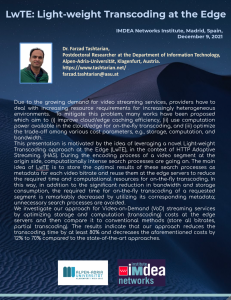We happily announce, the #Emmy Award Bitmovin (link) for innovation in online TV for @bitmovin arrived at University of Klagenfurt.
We happily announce, the #Emmy Award Bitmovin (link) for innovation in online TV for @bitmovin arrived at University of Klagenfurt.
Alexander Lercher’s Master Thesis titled ‘Context-aware Community Evolution Prediction in Distributed Social Networks‘ under the supervision of Prof. Radu Prodan at ITEC has been awarded outstanding academic thesis and a grant of 600 Euros in the field of digitization for Master’s Category. This work received funding from European Union’s Horizon 2020 research and innovation programme, grant agreement 825134, “Smart Social Media Ecosystem in a Blockchain Federated Environment (ARTICONF)”. The award ceremony will take place on Wednesday, November 24th, 2021 at 11 a.m. in the mirror hall of the Carinthian Provincial Government.
Farzad Tashtarian is invited to talk on “LwTE: Light-weight Transcoding at the Edge” at IMDEA Networks Institute, Madrid, Spain.

You are a Master Student and want to get to know more about ATHENA in a 3 months ATHENA internship in 2022?
Come and join our team! Apply now.
(Please note: application deadline is 14 December 2021)
Title: FSpot: Fast Multi-Objective Heuristic for Efficient Video Encoding Workloads over AWS EC2 Spot Instance Fleet
Authors: Anatoliy Zabrovskiy, Prateek Agrawal, Vladislav Kashansky, Roland Kersche, Christian Timmerer, and Radu Prodan
Abstract: HTTP Adaptive Streaming (HAS) of video content is becoming an undivided part of the Internet and accounts for most of today’s network traffic. Video compression technology plays a vital role in efficiently utilizing network channels, but encoding videos into multiple representations with selected encoding parameters is a significant challenge. However, video encoding is a computationally intensive and time-consuming operation that requires high-performance resources provided by on-premise infrastructures or public clouds. In turn, the public clouds, such as Amazon elastic compute cloud (EC2), provide hundreds of computing instances optimized for different purposes and clients’ budgets. Thus, there is a need for algorithms and methods for optimized computing instance selection for specific tasks such as video encoding and transcoding operations. Additionally, the encoding speed directly depends on the selected encoding parameters and the complexity characteristics of video content. In this paper, we first benchmarked the video encoding performance of Amazon EC2 spot instances using multiple x264 codec encoding parameters and video sequences of varying complexity. Then, we proposed a novel fast approach to optimize Amazon EC2 spot instances and minimize video encoding costs. Furthermore, we evaluated how the optimized selection of EC2 spot instances can affect the encoding cost. The results show that our approach, on average, can reduce the encoding costs by at least 15.8% and up to 47.8% when compared to a random selection of EC2 spot instances.
Keywords: EC2 Spot instance, Encoding time prediction; adaptive streaming; video transcoding; Clustering; HTTP adaptive streaming; MPEG-DASH; Cloud computing; optimization; Pareto front.
The Fast Multi-Resolution and Multi-Rate Encoding for HTTP Adaptive Streaming Using Machine Learning paper from ATHENA lab has won the Best New Streaming Innovation Award in the Streaming Media Readers’ Choice Awards 2021.

The journey that led to the publication of the FaRes-ML paper was quite an insightful one.
It all started with the question, “How to efficiently provide multi-rate representations over a wide range of resolutions for HTTP Adaptive Streaming?“. This led to the first publication, Fast Multi-Rate Encoding for Adaptive HTTP Streaming, in which we proposed a double-bound approach to speed up the multi-rate encoding. After analyzing the results, we saw room for improvement in parallel encoding performance, which led to the second publication Towards Optimal Multirate Encoding for HTTP Adaptive Streaming. The results were promising, but we believed we could improve the encoding performance by utilizing machine learning. That was the primary motivation behind our third paper, FaME-ML: Fast Multirate Encoding for HTTP Adaptive Streaming Using Machine Learning. In FaMe-ML, we have used convolutional neural networks (CNNs) to use the information from the reference representation better to encode other representations, resulting in significant improvement in the multi-rate encoding performance. Finally, we proposed FaRes-ML to extend our FaME-ML approach to include multi-resolution scenarios in Fast Multi-Resolution and Multi-Rate Encoding for HTTP Adaptive Streaming Using Machine Learning paper.
Here is the list of publications that led to FaRes-ML:
Taichung, Taiwan, The 1st IEEE International Workshop on Data-Driven Rate Control for Media Streaming (DDRC’21) Co-located with the IEEE International Conference on Multimedia Big Data (BigMM’21)
Conference Website: https://www.bigmm.org/ (November 15-17)
HTTP Adaptive Streaming (HAS) — Quo Vadis?
Speaker: Professor Christian Timmerer
Time: November 16, 2021 12:10 (UTC +1)
CAdViSE or how to find the Sweet Spots of ABR Systems
Speaker: Babak Taraghi, M.Sc.
Time: November 16, 2021 13:00 (UTC +1)
Online attendance is free, Visit here for more information.
Over the past decade, Carinthia has developed into a hotspot in drone research. The heart of the scientific operation is Europe’s largest drone hall in Klagenfurt.
The newspaper “Stuttgarter Nachrichten” reported on our drone work with its own article (link).
April 05-08, 2022 | Qui Nhon, Vietnam
Jesús Aguilar Armijo (Alpen-Adria-Universität Klagenfurt), Ekrem Çetinkaya (Christian Doppler Laboratory ATHENA, Alpen-Adria-Universität Klagenfurt), Christian Timmerer (Alpen-Adria-Universität Klagenfurt) and Hermann Hellwagner (Alpen-Adria-Universität Klagenfurt)
Abstract: As the video streaming traffic in mobile networks is increasing, improving the content delivery process becomes crucial, e.g., by utilizing edge computing support. At an edge node, we can deploy adaptive
bitrate (ABR) algorithms with a better understanding of network behavior and access to radio and player metrics. In this work, we present ECAS-ML, Edge Assisted Adaptation Scheme for HTTP Adaptive Streaming
with Machine Learning. ECAS-ML focuses on managing the tradeoff among bitrate, segment switches and stalls to achieve a higher quality of experience (QoE). For that purpose, we use machine learning techniques
to analyze radio throughput traces and predict the best parameters of our algorithm to achieve better performance. The results show that ECAS-ML outperforms other client-based and edge-based ABR algorithms.
Keywords: HTTP Adaptive Streaming, Edge Computing, Content Delivery, Network-assisted Video Streaming, Quality of Experience, Machine Learning.
April 05-08, 2022 | Qui Nhon, Vietnam
Ekrem Çetinkaya (Christian Doppler Laboratory ATHENA, Alpen-Adria-Universität Klagenfurt), Minh Nguyen (Christian Doppler Laboratory ATHENA, Alpen-Adria-Universität Klagenfurt), and Christian Timmerer (Christian Doppler Laboratory ATHENA, Alpen-Adria-Universität Klagenfurt)
Abstract: Deep neural network (DNN) based approaches have been intensively studied to improve video quality thanks to their fast advancement in recent years. These approaches are designed mainly for desktop devices due to their high computational cost. However, with the increasing performance of mobile devices in recent years, it became possible to execute DNN based approaches in mobile devices. Despite having the required computational power, utilizing DNNs to improve the video quality for mobile devices is still an active research area. In this paper, we propose an open-source mobile platform, namely MoViDNN, to evaluate DNN based video quality enhancement methods, such as super-resolution, denoising, and deblocking. Our proposed platform can be used to evaluate the DNN based approaches both objectively and subjectively. For objective evaluation, we report common metrics such as execution time, PSNR, and SSIM. For subjective evaluation, Mean Score Opinion (MOS) is reported. The proposed platform is available publicly at https://github.com/cd-athena/MoViDNN
Keywords: Super resolution, Deblocking, Deep Neural Networks, Mobile Devices